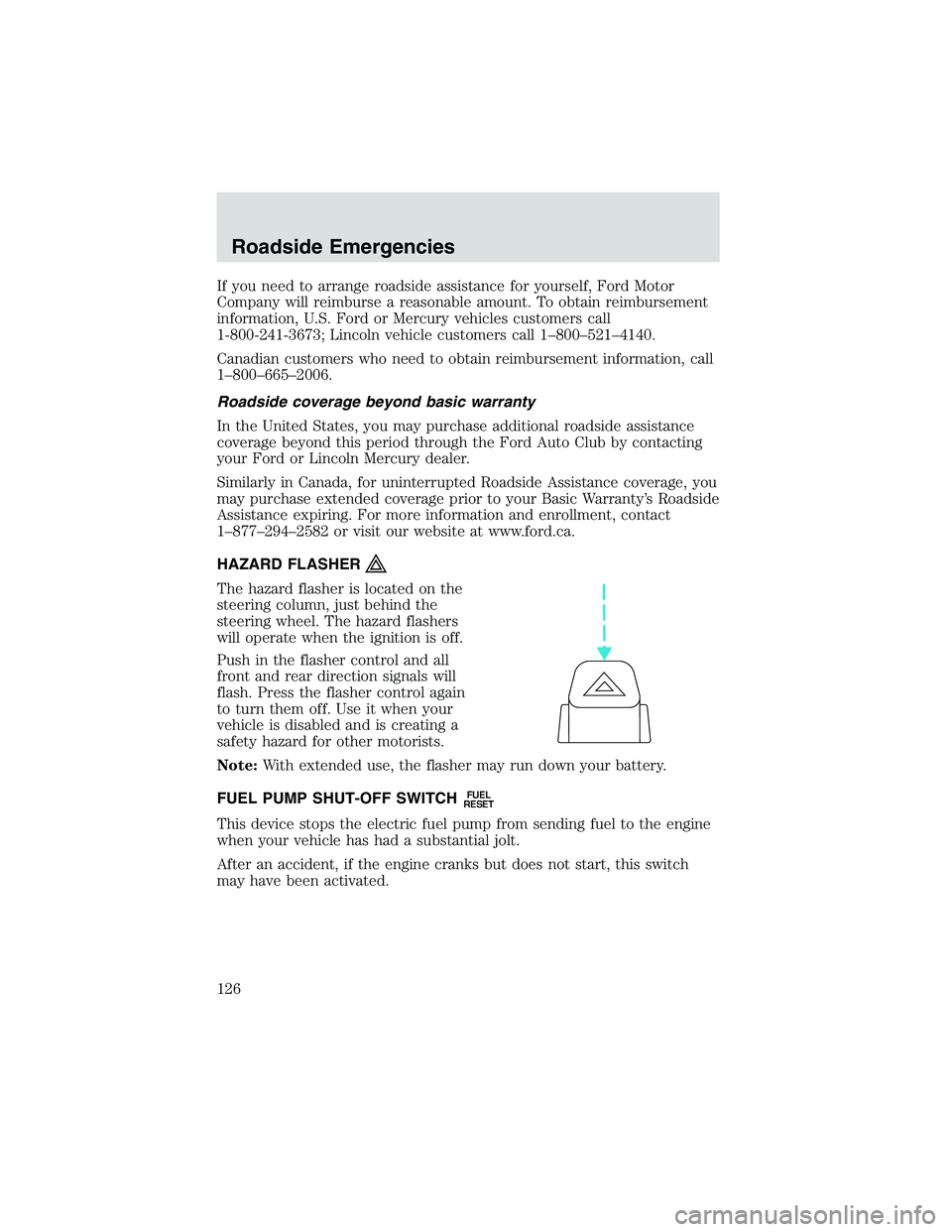Page 126 of 200

If you need to arrange roadside assistance for yourself, Ford Motor
Company will reimburse a reasonable amount. To obtain reimbursement
information, U.S. Ford or Mercury vehicles customers call
1-800-241-3673; Lincoln vehicle customers call 1–800–521–4140.
Canadian customers who need to obtain reimbursement information, call
1–800–665–2006.
Roadside coverage beyond basic warranty
In the United States, you may purchase additional roadside assistance
coverage beyond this period through the Ford Auto Club by contacting
your Ford or Lincoln Mercury dealer.
Similarly in Canada, for uninterrupted Roadside Assistance coverage, you
may purchase extended coverage prior to your Basic Warranty’s Roadside
Assistance expiring. For more information and enrollment, contact
1–877–294–2582 or visit our website at www.ford.ca.
HAZARD FLASHER
The hazard flasher is located on the
steering column, just behind the
steering wheel. The hazard flashers
will operate when the ignition is off.
Push in the flasher control and all
front and rear direction signals will
flash. Press the flasher control again
to turn them off. Use it when your
vehicle is disabled and is creating a
safety hazard for other motorists.
Note:With extended use, the flasher may run down your battery.
FUEL PUMP SHUT-OFF SWITCH
FUEL
RESET
This device stops the electric fuel pump from sending fuel to the engine
when your vehicle has had a substantial jolt.
After an accident, if the engine cranks but does not start, this switch
may have been activated.
Roadside Emergencies
126
Page 129 of 200
The fuses are:
Fuse/Relay
LocationFuse Amp
RatingPassenger Compartment Fuse
Panel Description
1 5A Mirrors, Autolamp
2 7.5A Cluster, Autolamp. Generic
Electronic Module (GEM),
Keyless entry, 4x4
3 7.5A Trailer tow right-hand stop/turn
lamps
4 7.5A Starter
5 15A Park lamps, Autolamps, I/P
dimming, Trailer tow
6 7.5A Air bags, Cluster
7 7.5A Trailer tow left-hand stop/turn
lamps
8 7.5A Cluster, Audio, GEM
1 234
5 678
9101112
13 14 15 16
17 18 19 20
21 22 23 24
25 26
29 30
35 36
313233
34
27 28
Roadside Emergencies
129
Page 170 of 200

Running out of fuel
Running out of fuel may have an adverse affect on powertrain
components.
•You may need to cycle the ignition from off to on several times after
refueling to allow the fuel system to pump the fuel from the tank to
the engine.
•Your“Check Engine”indicator may come on.
Fuel filler cap
When fueling:
1. Turn the engine off.
2. Carefully turn the filler cap counterclockwise 1/8 of a turn until it
stops.
3. Pull to remove the cap.
4. To install the cap, align the tabs on the cap with the notches on the
filler pipe.
5. Turn the filler cap clockwise 1/8 of a turn until it stops.
If the“Check Fuel Cap”indicator
illuminates and stays on after you
start the engine, the cap may not be
properly installed.
If you must replace the fuel
filler cap, replace it with a fuel filler cap that is designed for your
vehicle.
If you do not use the proper fuel filler cap, excessive pressure or
vacuum in the fuel tank may damage the fuel system or cause
the fuel cap to disengage in a collision, which may result in personal
injury.
Fuel filter
Refer to theScheduled Maintenance Guidefor the appropriate
replacement intervals. Replace the fuel filter with an authorized
Motorcraft part.
ESSENTIALS OF GOOD FUEL ECONOMY
We do not recommend taking fuel economy measurements during the
first 1,600 km (1,000 miles) of driving. You will get a more accurate
measurement after 3,000 km - 5,000 km (2,000 miles - 3,000 miles)
CHECK
FUEL
CAP
Maintenance and Specifications
170
Page 173 of 200

The following signs could indicate a problem with your emission control
system:
•Fluid leaks
•Strange odors
•Smoke
•Loss of engine power
•Illumination of the charging system, temperature, or“Check Engine”
light in the instrument panel.
Exhaust leaks may result in harmful and potentially lethal fumes
entering the passenger compartment.
It is unlawful to intentionally remove an emission control device or
prevent it from working. Information about your vehicle’s emission
system is on the Vehicle Emission Control Information decal located on
or near the engine.
READINESS FOR INSPECTION/MAINTENANCE (I/M) TESTING
It may be a legal requirement in your area to pass an I/M test of the
on-board diagnostics system. If the system or battery has just been
serviced, the on-board diagnostic system is reset to a“not ready for I/M
test”condition. To ready the system, allow the vehicle to sit for at least
eight hours without starting. Then, start the engine and complete the
following driving cycle:
1. Drive on an expressway or highway for at least 10 minutes.
2. Drive in stop-and-go traffic for at least 20 minutes with a minimum of
four idle periods.
The engine must warm up to its normal operating temperature. Once
started, do not turn off the engine until the above drive cycle is
complete.
Note:If your“Check Engine”light is on, your vehicle may not pass an
I/M test.
Maintenance and Specifications
173